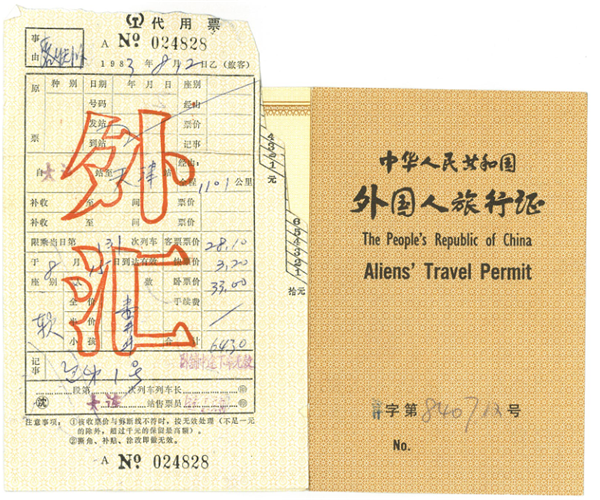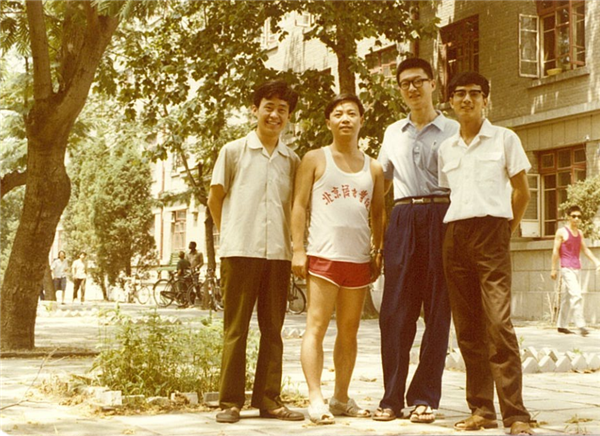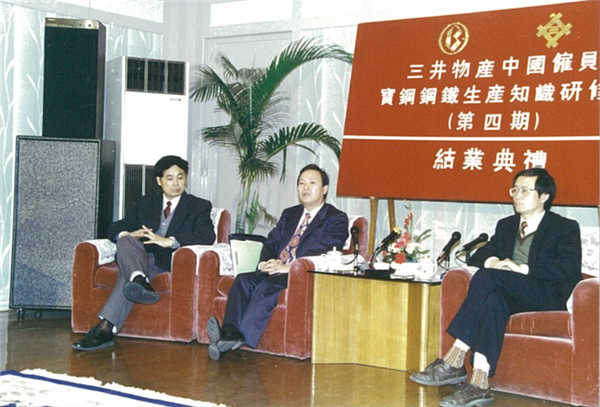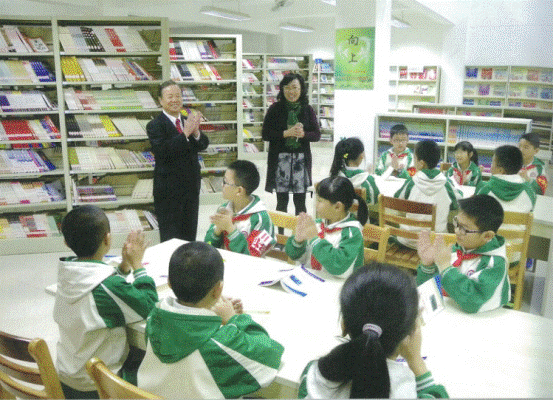He was born in 1950 in the city of Gifu, the only place with a name of Chinese origin in Japan. In 1972, China and Japan normalized their diplomatic relations and when graduation approached, he desired to be involved in China-related jobs. So he joined Mitsui & Co, an integrated Japanese commercial firm. In 1979, he came to China among the first batch of exchange students of Mitsui & Co. In 1995, he came to Shanghai as the General Manager of Mitsui & Co Shanghai and later received two Magnolia Awards. He came back to Shanghai as the General Manager of the Shanghai World Financial Center in 2014 and was granted a permanent residence permit before he moved back to Japan. He is Hideyuki Hoshiya, a Japanese with deep ties to China.

Hideyuki Hoshiya shared with us his experiences
Determined his life purpose during his study in Beijing
In 1972, when Hideyuki Hoshiya knew from news reports that Tanaka Kakuei, then Prime Minister of Japan, had visited China, he felt that a new era for close Sino-Japanese exchange would come. Majoring in civil engineering, he chose to work for Mitsui & Co under the advice of his teacher. He was assigned to the domestic business department of the steel division after he joined the company in 1974 and was mainly involved in the domestic sales of steel. In 1978, the Sino-Japanese Peace Treaty was signed and Deng Xiaoping paid a visit to Japan. After Deng visited the Nippon Steel Kimitsu Works, he expressed the hope that Nippon Steel would help build the Baoshan Steel Works or Baosteel for short. Since Mitsui & Co was an export trade partner of Nippon Steel, it also needed to nurture a group of employees with Chinese language capability. Hideyuki Hoshiya took the challenge without any hesitation and finally embarked on his journey to China.
On September 8, 1979, Hideyuki Hoshiya boarded flight JL781 of Japan Airlines with a suitcase in which there was a second-hand copy of Quotations from Chairman Mao Tse-tung, a dictionary, a camera, a recorder and some necessities, and soon set foot in China. He became a student of the Beijing Language and Culture University for one-year of study and started his deep relationship with China.
Upon arrival in China, Hideyuki Hoshiya found there were not many airplanes at the Beijing Capital International Airport and the facilities were outdated. The roads leading to the Beijing Language and Culture University were agricultural roads where a flock of sheep might appear from time to time. The canteens, toilets, showers and dormitory rooms there were old, outmoded and with poor hygiene conditions. Among the exchange students, most of them were from developing countries including Africa, the Middle East, Eastern Europe and North Korea. Hideyuki Hoshiya was understandably quite worried about his one-year study life in China.

The Foreign Exchange Certificate (left) and the Alien's Travel Permit (right) Hideyuki Hoshiya used during his study in China
There were barely any cars on the streets but there were buses and numerous bicycles. Most people on the streets were dressed in a Zhongshan suit, which conveyed a drab appearance en masse. Hideyuki Hoshiya could feel better only when he looked up at the well-known “Beijing Autumn” blue sky. There were a poor variety of commodities in the famous Wangfujing Mall and there was no enthusiasm on the faces of retail clerks. He had to address those service people in canteens, shopping malls, hotels or on buses as comrade. Foreigners needed to use Foreign Exchange Certificates to shop and food ration coupons to dine at a canteen as well as a Domestic Travel Permit when they were going to leave Beijing for other places. Hideyuki Hoshiya found it hard to get used to life under the Planned Economy.

Hideyuki Hoshiya (second from left) pictured with his school mates at the Beijing Language and Culture University; the first from right was Xu Jingbo, currently a Professor at the Center for Japanese Studies, Fudan University
However, Hideyuki Hoshiya tried very hard to adjust and soon accommodated himself to life in Beijing and travelled all around to know more about the history and culture of China. He made a lot of good friends during that period. Moreover, he contributed an article to the People's Daily titled My Hometown, which was published soon after he returned to Japan. It was said this was the first foreign-authored article published by the People's Daily.
In December 1979, the Japanese Prime Minister Masayoshi Ohira delivered a speech at the Chinese People's Political Consultative Conference Hall in which he said, "The whole of Japan will provide assistance to the economic development of China and promote Sino-Japanese cooperation among enterprises, citizens and universities and so on. Even if China and Japan might go through a lot of ordeals in the 21th century, the two countries can still go hand in hand in the future, given the context of a two-thousand year history of friendly Sino-Japanese exchange." Hideyuki Hoshiya felt enthused upon hearing these words and thus determined his life purpose—Sino-Japanese exchange. It can be said that Prime Minister Masayoshi Ohira's speech in Beijing had determined the direction of Hideyuki Hoshiya's life.
A witness of Pudong and Baosteel's development in the new era of Sino-Japanese exchange
Hideyuki Hoshiya was soon dispatched to Tianjin to head the Tianjin Office of Mitsui & Co. As the head of the Tianjin Office, Hideyuki Hoshiya was concerned about the plant construction of the first phase of the Baosteel project. He came to the construction site of the No.1 blast furnace of the steel plant and was moved by the enthusiasm of the people involved in the Sino-Japanese cooperation project. He was then sure about the coming of a new era of Sino-Japanese exchange.
After Nippon Steel helped build the steel plant for Baosteel and passed on their advanced steel manufacturing techniques to Baosteel, they also needed a Japanese integrated commercial firm to handle distribution. In 1990, Hideyuki Hoshiya received a special order from the management of Mitsui & Co to establish a business cooperation system with Baosteel and propose a strategic cooperation solution to them. He then traveled to Shanghai on a monthly basis for negotiations. In 1991, a Comprehensive Cooperation Agreement was signed between Mitsui & Co and Baosteel. According to the agreement, the two sides would carry out talents exchange and hold specialized seminars on the market economy to promote trade and investment as well as cadre exchange.
In 1995, Hideyuki Hoshiya was dispatched to Shanghai again as General Manager of Mitsui & Co Shanghai Ltd. He and his family thus moved to Shanghai and resided in Hongqiao Villa. They employed a housekeeper so that his wife and her Japanese friends could shop and have fun together. The Hongqiao branch of the Shanghai Japanese School was close to their home so that his kids could go to school conveniently and there was no bullying in the school. His family soon accommodated themselves into the life in Shanghai and became fans of the city.
Compared with his earlier visits, Hideyuki Hoshiya felt that Shanghai's lifestyle had completely changed. Metro Line 1 had started operation and the city was also building an expressway network. Many modern high-rise buildings had emerged and there was a rich variety of commodities in the commercial streets. The sales clerks were now all smiling. The clothes people wore were much more colorful than the dull and uniform Zhongshan suits. Shanghai had formed its own fashion and the gap between Shanghai and Tokyo was being narrowed. Hideyuki Hoshiya felt quite astonished at the speed of development in Shanghai.

In 1993, Hideyuki Hoshiya (middle) attended a specialized seminar on the market-oriented steel industry as part of a Baosteel workshop on steel manufacturing knowledge
The main mission for Hideyuki Hoshiya this time was to explain in detail the Japanese and American business models which combined the steel industry and the automobile industry,so as to finally find a "Chinese model". For this purpose, he organized a group of 20 people from Baosteel and Chinese automobile makers and spent three weeks visiting Japanese and American automobile enterprises, plants, steel processing center, research & development centers. The Chinese side was very interested in the Toyota’s Zero Inventory Management. After a few conversations, Baosteel and Mitsui & Co decided to unify the management of all their steel processing centers in China under a joint venture company. Besides, Hideyuki Hoshiya facilitated the cooperation between Baosteel and Shanghai General Motors Company Ltd.
He also paid a visit to Pudong soon after he reported for his new position. Mori Building, a partner of Mitsui & Co, had acquired land in Pudong New Area in 1994 and planned to build two skyscrapers. At that time, Pudong was still haphazardly strewn with warehouses, factories and agricultural fields. The plan to build an international trade and financial center there sounded incredible. The Shanghai local employees were skeptical about the idea and opposed the decision to move Mitsui & Co’s Shanghai office from Ruijin Building in Puxi to Shanghai Sen Mao International Building in Lujiazui, Pudong. However, Mori Building was the primary investor of Mitsui & Co and hoped that Mitsui & Co could move to their new office in Pudong soon.

In 1996, Hideyuki Hoshiya met with Zhao Qizheng, then Vice Mayor of Shanghai and Governor of Pudong New Area
Still unsure about the prospects, in March 1996, Hideyuki Hoshiya decided to meet with Zhao Qizheng, then vice mayor of Shanghai and governor of Pudong New Area, who quieted Hideyuki Hoshiya's doubts. He said that he would go on a business trip to Tokyo the next month and he would take that chance to explain to the management team of Mitsui & Co about the development and prospects of both Pudong and Shanghai’s economy. After that, the worries over the development in Pudong were gradually dismissed. Hideyuki Hoshiya told a local female employee who cried and opposed the decision to move to Pudong earlier that, "As a Japanese I am confident in the opening up and development of Pudong, so why aren't you confident as a Shanghainese?" The woman finally understood Mitsui & Co's decision to move their office. On June 20, 1996, as the first enterprise that had moved into Mori Building's new building, Mitsui & Co held a signing ceremony at the Okura Garden Hotel. At that moment, Hideyuki Hoshiya thought that as General Manager of Mitsui & Co Shanghai he would spare no efforts to develop Shanghai’s manufacturing industries, so as to repay the trust given by Shanghai local employees and the management of the Mitsui & Co Headquarters.
It turned out that as the Vice Mayor had promised, Pudong's business environment gradually improved, while Mitsui & Co developed and expanded with a significant growth in revenues in this new building and was praised by the Headquarters. During Hideyuki Hoshiya's 8-year tenure in Shanghai as General Manager, the company remained profitable, which proved that the decision to move to Pudong was correct.

In 1996, Mitsui & Co held a ceremony at the Okura Garden Hotel for moving into Shanghai Sen Mao International Building
In 2003, Hideyuki Hoshiya returned to the Headquarters in Tokyo but continued to be involved in the China-related Steel Division business. He acted as a special consultant for Mori Building in 2008 thanks to his help to Mori Building’s business in Shanghai. In 2014, when he turned 64 years old, he was dispatched to Shanghai again as the General Manager for Mori Building (Shanghai) Real Estate Management Consulting and Shanghai World Financial Center. His two-year tenure ended successfully.
Before he returned to Japan in 2017, he was invited by the Shanghai People's Publishing House to write and publish a book named A Bond with China——My Life Journey, in which he revisited his 40 years’ bond with China since his youth.
Sino-Japanese Exchange: A lifetime cause
Hideyuki Hoshiya has always been active in Sino-Japanese exchange. He made a donation during the Yangtze River flood in 1998. He gave the Complete Works of Nagai Kafu to Shanghai Fudan University as a gift. In 2015 and 2016, he invited the teachers and students from Dujiangyan Kuiguang Primary School, a school Mori Building helped build, to visit and take a tour in Shanghai. In 2015, he acted as a member of an evaluation committee for the Panda Cup Japan Essay contest for Young People.

In 2015, Hideyuki Hoshiya visited the Mori Memorial Library in Kuiguang Primary School.
To recognize his contribution to Shanghai during his tenure as General Manager of Mitsui & Co Shanghai, Hideyuki Hoshiya was granted two Magnolia Awards by the Shanghai Municipal Government, which were the Magnolia Silver Award in 1999 and Magnolia Gold Award in 2003 respectively.
He wrote a Chinese acrostic poem named "Feelings During my Stay in Shanghai" (the first character of each line spells out the Chinese words for Mitsui & Co Hideyuki Hoshiya) to express his emotions for Shanghai and expectations for Sino-Japanese exchange.
Here is a literal translation of the poem:
Three years will see tremendous changes in great Shanghai,
Being so organized and in order is the New Pudong Area,
Affluent resources and materials depend on trade,
Advanced industries shall attach importance to distribution,
As shiny as the stars and moon is the Sino-Japanese bond,
The buildings are tall and magnificent,
Young ladies and men are working hard together,
To create a happy life and a wonderful new era.
To deepen the bond between this Magnolia Award winner and Shanghai, he proposed to establish a Club for Japanese Winners of the Award and was supported by the Shanghai People's Association for Friendship with Foreign Countries (SPAFFC). The Magnolia laureates gather in Shanghai or Tokyo every year. The event has been successfully held for 5 years.
In the fall of 2017, the Shanghai Municipal Government contacted Hideyuki Hoshiya to grant him a permanent residence permit. He hesitated initially because after he went back to Japan, each of his business trips to Shanghai could not exceed 90 days. However, a friend of his with the SPAFFC suggested that he could contribute more to the friendly Sino-Japanese exchange beyond his business trips. So he was determined that as long as he is still healthy he will continue to serve the civil exchange between Chinese and Japanese people.

Hideyuki Hoshiya's best wishes for China's reform and opening up:Sino-Japanese Friendship embraces a new era; the Belt and Road initiative brings new hope.
This year marks both the 40-year anniversary of China's reform and opening up and the 40-year anniversary of the signing of the Sino-Japanese Treaty of Peace and Friendship. The Sino-Japanese relationship is of great importance in Asia. In the future, the principle of mutual benefit, equality and humble exchange should still be followed to develop the Sino-Japanese relationship. Hideyuki Hoshiya hopes that young people of the two countries will increase their exchanges beyond business, travel to more places, participate in wide exchange in areas like culture and sports and enhance their friendship. He believes in the unlimited potential of Sino-Japanese exchange.
